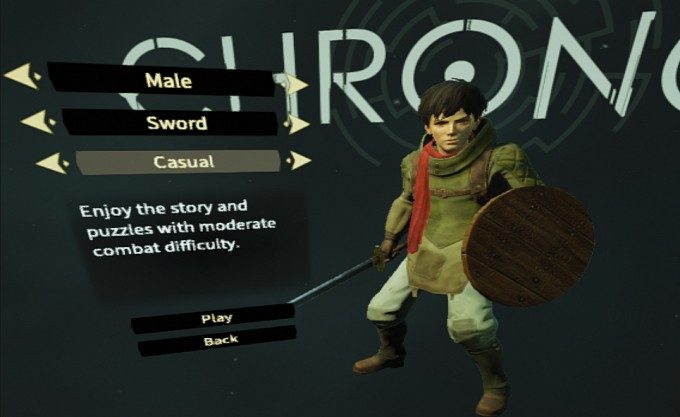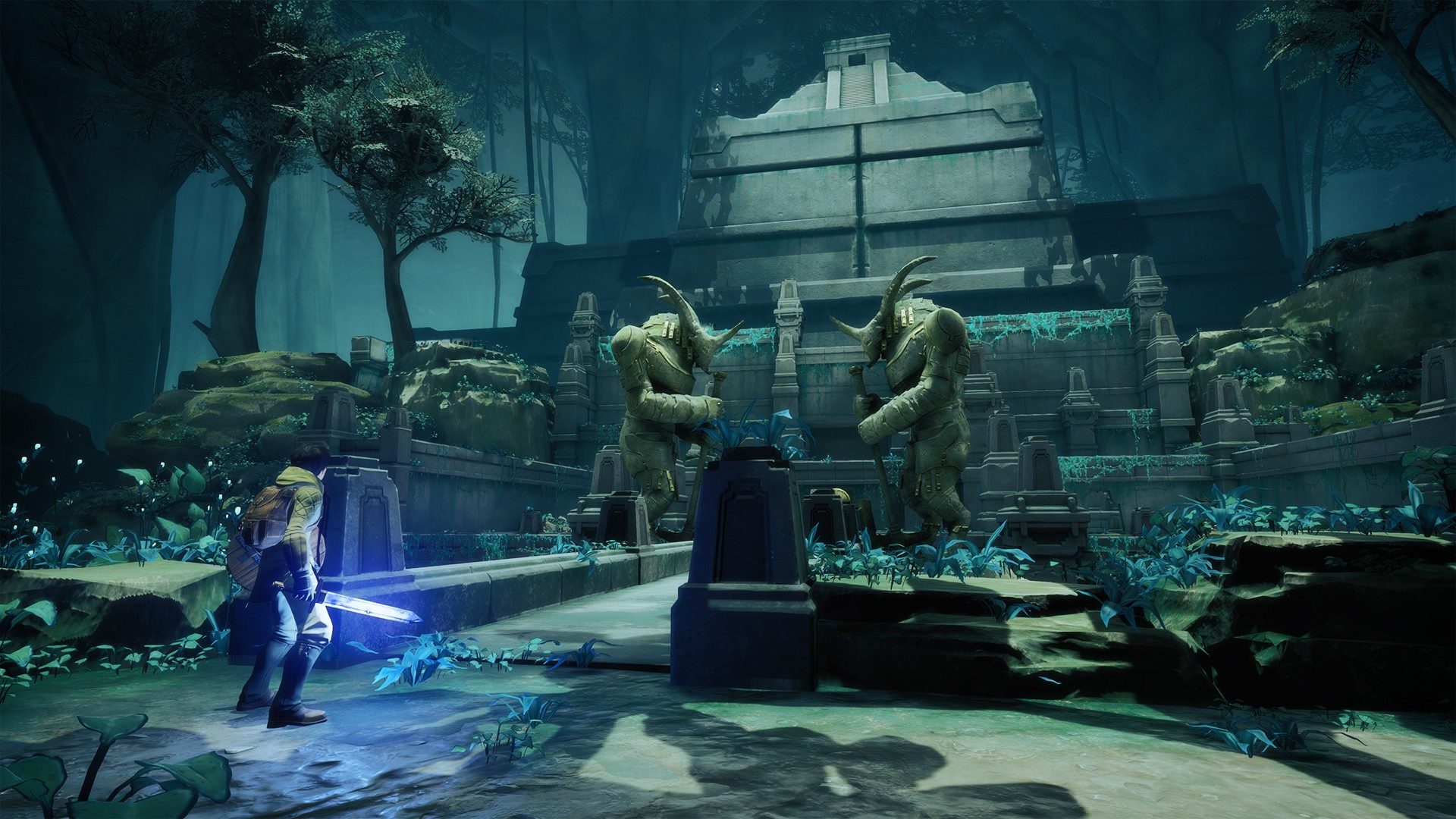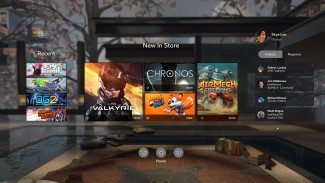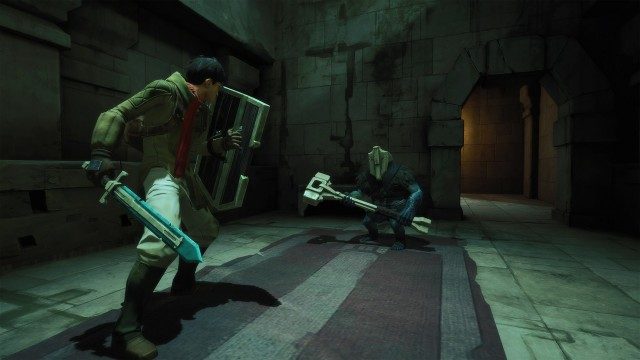Chronos is a third-person action-adventure game, that much like the Dark Souls series and Bloodborne, is taking gaming back to its roots. It delivers a no-nonsense, high-stakes gaming experience that isn’t afraid to punish you with far-flung checkpoints and dungeons repopulated with baddies when you die. And you will die—over and over—until Chronos gets what it wants from you: your very best effort.
Starting out with either an axe or a sword, you leap through a multi-dimensional transport crystal to hunt down a dragon that has ruined your world. As an interesting mix of high-fantasy and a retro post-apocalyptic world, Chronos gives you plenty to gawk at, and even more to worry about as you hack and slash your way through dimensions. To preserve the secrecy of the narrative, we won’t go into much more detail than that, but suffice it to say that there’s way more to it than just a trans-dimensional dragon.
In Chronos, you aren’t given the plethora of choices like other adventure RPGs, where convenient shops offering weapons, armor, and hi-potions line the road to the big boss. There is no magical chest that makes your journey any easier, no giant XP boost after you beat a boss. There are however two ways to get through the game with less difficulty, but don’t expect any sugar-coating here either. Chronos punishes the weak.
Predictably, the first way to lower the difficulty is to change the game to ‘casual’, but they aren’t talking about the game mode specifically. They’re talking about you. You’re the casual. And whether you’re comfortable accepting that title, which has become a derogatory label for lower-skilled gamers, is entirely up to you. Chronos just wants to hear the words come out of your mouth. Say it. Say you’re a filthy casual.

The second way is by dying. Well, technically you don’t die when you get slashed to pieces, you travel back through the teleport crystal to your homeworld where you spend a full year in recovery (unseen to the player). You’re then restocked with ‘Dragon Hearts’, the game’s extremely scarce health potion, and sent on your merry way to re-kill every mob between you and your next teleport crystal—wherever that’s supposed to be.

Here’s the rub: With every decade that passes (ten deaths) your character gets a boost in an ability of your choice: strength, agility, arcane magic, etc., until you gradually reach an equilibrium of difficulty. Soon your shield blocks become stronger, your dodges become easier to execute against enemies—not to mention the amount of enemies you have to slice through naturally give your XP a much-needed boost. You get what you need when you need it, but only just enough to keep you charging forward.
There is a final, and slightly shameful safety net in place. At the age of 80 (I had to jump off a cliff repeatedly to find out), your character is given immortality, which isn’t to say you’re given god mode, it just means you’ll never be booted from the game for being too old. You’re expected to continue on until you finish, nary a single ‘Game Over’ in sight. To me, this catch-all safety net runs counterintuitive to the whole ‘bad ass hard game’ mentality that Chronos has shaped up to be, and it doesn’t fit in with my expectations of the world created around me.
Are things immortal? Why am I immortal? I played my first time through without any knowledge of this, always with the phrase implanted in my mind from the wise woman from the intro: “Kill the dragon or die trying.” I didn’t want it to be easier, I wanted to get better, and I was disappointed to see that my hard work, my badge of courage for beating the game straight through, could be diminished so easily by a single automatic perk. C’est la game.
Game Play
The level design is nothing short of elegant. There are no dead ends in Chronos, only circuitous routes that unlock once inaccessible doors, making a return total trip through the level a little less harsh. The final door on each level (usually near the level boss) leads you back to the previous checkpoint so the journey to the boss is only a few rooms away. Despite going through well-trodden territory as you move forward, there’s always a clear mission in mind, a key that opens a door, or a puzzle that needs a piece to function, and I never felt like I was without a task that was leading me forward.

Clocking in at around 10 hours of play time, the game offers little in terms of side missions, although there are a few I ran into based on my penchant to loot everything I see. I attribute this to a tight story line, and a serious ‘no bullshit filler’ type of attitude, which isn’t always the case in games looking to squeeze out more for the sake of longer-sounding duration. The storyline (no spoilers) is standard fare for these sorts of games—beat the dragon and save the village—but it definitely engages the VR user directly. I wouldn’t want to say any more than that.

Combat isn’t easy, and requires you to be well-versed with how to dodge, block, and strike as you assess each enemy’s combat style. Misreading the enemy was probably the reason for most of my deaths. The ‘easy-button’ here is the special elemental ability, which can be charged up by correctly executing dodges and being an all-around badass. If you’re garbage with these sorts of things, Chronos will punish. If you’re not careful where you walk, Chronos will punish. If you forget where the hell you are, Chronos offers no map to find yourself, so you will be punished.
What About VR?
This is all well and good, but why does a third-person game like Chronos need VR? The answer: to deliver immersive visuals and direct your attention to smaller details.
Because it’s a third-person game, your POV is centered in a predetermined spot in each room, kind of like you’re a security camera. Each time your avatar walks to a different room, your POV is transported to the new position, much like the studio’s Gear VR original Herobound: Spirit Champion. At first this was a little jarring, but I soon was able to predict when I would jump to the next observation point, so it became second nature as I hit my stride. This style of game is, and will always be one of the most comfortable ways to play, simply because it asks nothing of your vestibular system, or your body’s inner ear, which can go out of whack with more intense virtual locomotion schemes.
Chronos is stunningly beautiful, and while every room in each of the four worlds isn’t always worth your time, most of them deserve a good look-over to appreciate the attention to detail. That said, you have to crane your neck to take in the world’s massive structures, statues, and enemies that tower over your plucky little avatar—truly giving you a sense of the gargantuan task at hand. And you won’t be facing forward during combat either, as many times I found myself frantically scouting out the whole room visually to get a good count on the baddies within, or following my character through a large room with my gaze as I fought a boss.
I didn’t expect to be immersed in a third-person game so easily, although my favorite moments are when you select a book or scroll, and automatically zoom into a first-person view. This little trick, likely used out of pure necessity to make text readable, strangely made me want to read the lore of each world and go through it, whereas I’d usually just ignore it if it weren’t immediately necessary (I have a house full of books in Skyrim that I never intend on reading).
Final Thoughts
Playing Chronos is a pain that hurts so good, and it’s easy to see how this game will appeal to Oculus’ target audience: serious gamers looking for a new and interesting challenge. While the game’s catch-all safety net is a bit of a turn-off, it isn’t going to affect you if you’re honestly trying, as the game ideally pushes you just to the brink of your ability to stay alive against an onslaught of not-so-easy AI, and keeps punishment strict enough to make you want to consolidate the number of times you die to a minimum. I would still like to see a final ‘You suck, go home’ when you reach 80 to underline just how unforgiving the title is supposed to be, but I suppose if you reach the safety net, you know that already.
The story was well-structured, if not a little predictable at least. I began to guess outcomes around half-way through, some of which panned out. This isn’t a hackneyed trope-fest though, so you’ll either view the story as standard and inoffensive, or perfectly interesting depending on your exposure to the genre. There is plenty of books, scrolls, and computer logs to read though if you want to bite into it a little more.
Chronos makes good use of the VR headset, requiring you to actively look around for items, and zooming you into first-person for puzzles and readable text. Although it’s not boasting anything crazy unique in terms of virtual interaction, the game is a solid purchase for anyone looking to wear in their new headset, and finally complete their first AAA title in virtual reality.









